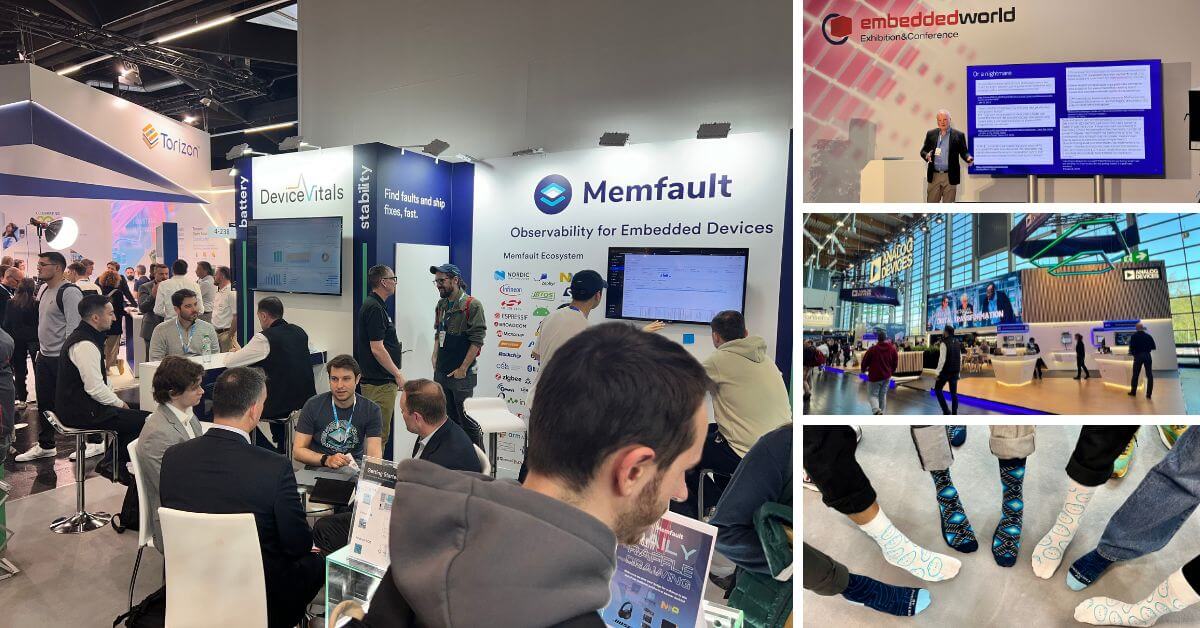Share
Embedded World is one of the industry’s premier events, bringing together professionals from around the globe to explore the trends and innovations shaping the embedded technology landscape. The Embedded World 2024 event in Nuremberg, Germany set a new standard, drawing an impressive 27,000 attendees and solidifying its place as a must-attend event.
And the excitement continues to build, with Embedded World North America making its debut in Austin this October. If you’re considering attending, this blog offers a sneak peek into what you can expect, based on the key highlights and insights from the Nuremberg event.
As a proud sponsor, Memfault will have a front-row seat in Austin as well. We look forward to seeing you there!
1. Software Takes Center Stage
One of the most striking observations from Embedded World 2024 is the evolving landscape towards software-centric development. What used to be predominantly a hardware-focused conference has transformed into a hub for software innovation, such as IoT device management software. The number of embedded software vendors has exploded over the years, indicating a significant shift in industry priorities.
Software-defined vehicles emerged as a dominant theme, highlighting the automotive industry’s growing reliance on sophisticated software solutions. The concept revolves around vehicles receiving feature updates and improvements over-the-air (OTA), optimizing performance and enabling autonomous driving capabilities.
It’s not just about cars running software anymore; it’s about creating a robust ecosystem for continuous management, enhancement and customization.
Related: Wakeup Call to IoT Developers: You’re a Software Company Now
2. AI Integration at the Edge
Artificial Intelligence (AI) in embedded systems was another hot topic at Embedded World 2024, echoing broader industry trends. Edge AI, in particular, garnered substantial attention, reflecting the push towards AI-enabled solutions within the embedded industry.
Companies showcased various AI applications, from speech-to-text algorithms for faster dictation to innovative uses like generating driver code from reference manuals using AI models.
The increasing adoption of AI in embedded systems underscores its potential to enhance functionalities and drive efficiency. It’s not just the tinyML Foundation anymore. New startups are pushing boundaries, demonstrating how AI can streamline IoT product development processes and solve complex engineering challenges.
3. Rising Stars and Notable Embedded Technologies
A standout technology this year was Rust, which made significant strides in gaining industry traction. Companies across different sectors highlighted Rust’s role in enhancing device security and integrity within embedded systems. From compiler tools to custom RTOS development, Rust is emerging as a viable alternative to traditional programming languages like C89. In fact, we might finally be able to say goodbye to C89 forever.
The enthusiasm around Rust signals a broader shift towards leveraging open-source communities and modern languages to address evolving demands in IoT product development.
Zephyr is also generating strong buzz. Various semiconductor companies are looking at developing Zephyr support, both through ensuring good board support in the Zephyr RTOS and having their own SDK written as a Zephyr module. Zephyr has really drawn in a lot of IoT product developers for its superb community and board support, and semiconductor companies are catching on.
Related: Practical Zephyr: a 5-Part Blog Series
Another rising star worth noting: Matter. Touted as the foundation for connected things, Matter aims to make smart home devices secure, reliable, and seamless to use. ST has a new chip (the STM32WBA) that supports Matter, and Nordic and other vendors held demos for devices using Matter.
4. Cybersecurity and Regulatory Compliance
Amidst the buzz of innovation, cybersecurity emerged as a critical concern, driven in part by regulatory changes like the Cyber Resilience Act (CRA) in the EU. The CRA mandates stringent cybersecurity requirements for connected devices, emphasizing the need for robust vulnerability device management and OTA updates. This regulatory push is reshaping how IoT products are designed, with a renewed focus on ensuring long-term device security and resilience.
From more advanced static analysis for detecting security vulnerabilities to better tooling for managing trusted execution environments, many companies are very focused on improving security for embedded devices.
Related: Your Guide to Understanding the EU Cyber Resilience Act
5. Addressing IoT Device Connectivity Challenges
On a technical level, discussions at Embedded World highlighted the increasing complexity of cellular-based applications and the fragmentation of cellular networks globally. This underscores the importance of simplifying connectivity solutions for IoT devices, ensuring seamless integration across different regions and networks.
Related: Best Practices for Monitoring Device Connectivity
Practical Advice for Navigating the Future of IoT Product Development
Embedded World 2024 provided a compelling glimpse into the future of IoT product development. One thing is strikingly clear: the landscape of embedded technology is evolving rapidly. The convergence of hardware and software, coupled with advancements in security and AI in embedded systems, presents exciting opportunities for IoT product development.
Business leaders in this space should prioritize embracing software innovation, leveraging emerging technologies like Rust and AI, while also ensuring robust cybersecurity practices to navigate regulatory landscapes effectively. Moreover, addressing connectivity challenges and leveraging device management tools will be crucial for scaling IoT solutions globally.
Embedded World not only showcased cutting-edge technologies, but also underscored the collaborative spirit driving advancements in embedded systems. Along those lines, it’s important for developers to make interoperability a top consideration.
Ensure that each part of your software stack is flexible enough to work with different processors and sensors at the firmware level level, different RTOSs at the application level, and different cloud services at the application level and on the server side. Embedded systems is a very fragmented market, so it’s important to ensure interoperability to reduce risk in the case of chip shortages or deprecated support in your software stack.
Thank You to Our Embedded Industry Partners and Attendees
Huge thanks to our partners for teaming up on booth demos and discussions, especially The Zephyr Project, Nordic Semiconductor, Infineon Technologies, NXP Semiconductors, Blecon, and Conclusive Engineering.
Thank you to VDC Research for naming Memfault an Embeddy Software Winner, and congratulations to Advantech and Arm for winning the Embeddy Hardware Award and Embeddy IP Award, respectively. There are a lot of ARM-based chips out there! Their marketing touted over 270B chips shipped. Wow.
Last but certainly not least, a big thank-you to everyone who came by the Memfault booth at Embedded World 2024. We love getting to talk to people about the work they do and share what we’ve been working on. We also had fun seeing all the students and people getting excited to join the embedded device industry!
If you weren’t able to make the trek to Nuremberg to attend embedded world 2024, not to worry: the first embedded world North America will take place in October 2024 in Austin, Texas. If you’re going to market with an IoT product, you’ll find a number of IoT device management tools, monitoring solutions and embedded systems experts to help you. You can look forward to engaging discussions, exciting product demos, fresh perspectives—and perhaps a few more pairs of quirky Memfault socks to take home. Schedule a meeting with us at Embedded World North America. We hope to see you there!
The expansion of Embedded World events into the US and China is yet another indication of the strong demand and growth in the industry. That said, remember that Embedded World isn’t the only place to get a pulse on the community. Subscribe to embedded blogs like Interrupt by Memfault, attend embedded meetups, and watch as many virtual talks as you can.
Let’s continue to innovate and push the boundaries of what’s possible in the world of IoT and embedded systems—together.


